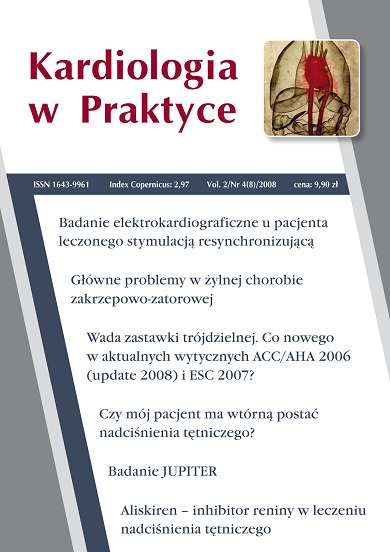Electrocardiography in patients with cardiac resynchronization therapy. Evaluation of the ECG – basic rules Review article
Main Article Content
Abstract
Cardiac resynchronization therapy (CRT) has been used in heart failure patients since 1994 and still is one of the most advanced forms of cardiac pacing. ECG interpretation should be performed as in patients with typical pacemakers. But complete medical assessment requires the knowledge of the effect of CRT on the heart function. What’s more, in order to maximize the benefit of CRT, proper patient management and device followup are crucial. It means very close cooperation between patient and doctor as well as between electrophysiologist and doctor from out-patient clinic.
Downloads
Article Details

This work is licensed under a Creative Commons Attribution-NonCommercial-NoDerivatives 4.0 International License.
Copyright: © Medical Education sp. z o.o. This is an Open Access article distributed under the terms of the Attribution-NonCommercial 4.0 International (CC BY-NC 4.0). License (https://creativecommons.org/licenses/by-nc/4.0/), allowing third parties to copy and redistribute the material in any medium or format and to remix, transform, and build upon the material, provided the original work is properly cited and states its license.
Address reprint requests to: Medical Education, Marcin Kuźma (marcin.kuzma@mededu.pl)
References
2. Guidelines for cardiac pacing and cardiac resynchronization therapy 2007.
3. Szulik M., Kukulski T.: Chory z przewlekłą niewydolnością serca i asynchronią skurczu lewej komory. Kwalifikacja do terapii resynchronizującej. Kardiologia po Dyplomie 2007, 7(6): 38-49.
4. McAlister F.A., Ezekowitz J., Hooton N.: Cardiac resynchronization therapy for patients with ventricular systolic dysfunction. A systematic review. JAMA 2007, 297: 2502-2514.
5. Braunwald E.: Choroby serca (wyd. 1 polskie). Banasiak W., Opolski G., Poloński L. (red.). Urban & Partner 2007, t. 2: 747-780.
6. Stanke A.: Elektrokardiogram bez tajemnic. Gdańsk 2002: 168-184.
7. Krupienicz A.: Stymulacja serca. Warszawa 2006.
8. Zapisy elektrokardiograficzne (materiał własny Kliniki).

